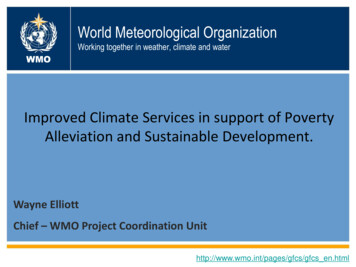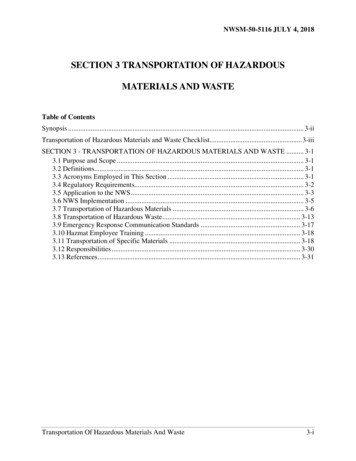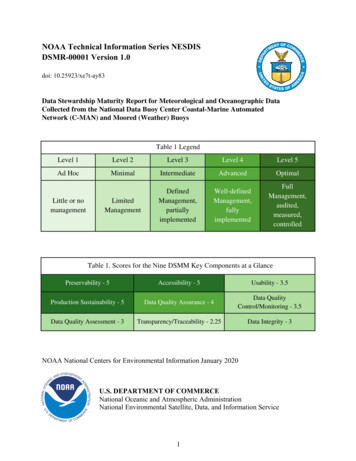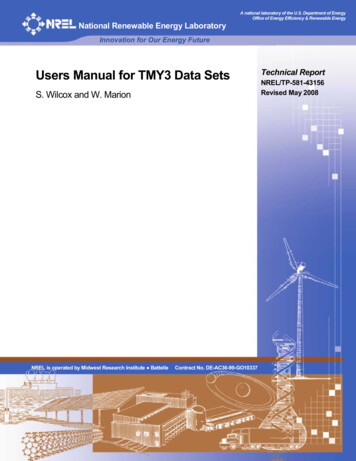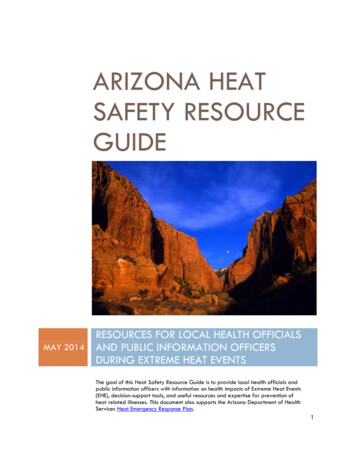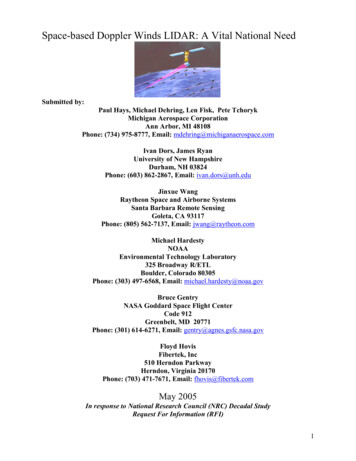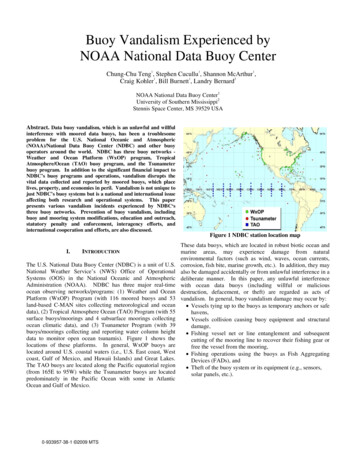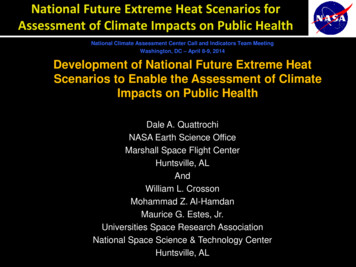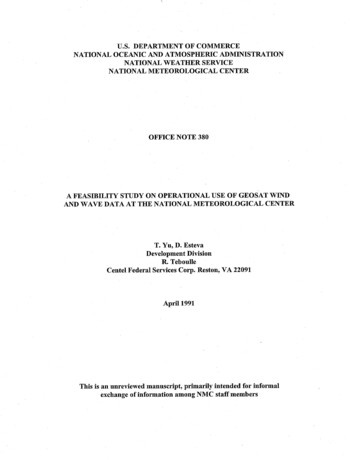
Transcription
U.S. DEPARTMENT OF COMMERCENATIONAL OCEANIC AND ATMOSPHERIC ADMINISTRATIONNATIONAL WEATHER SERVICENATIONALMETEOROLOGICAL CENTEROFFICE NOTE 380A FEASIBILITY STUDY ON OPERATIONAL USE OF GEOSAT WINDAND WAVE DATA AT THE NATIONAL METEOROLOGICAL CENTERT. Yu, D. EstevaDevelopment DivisionR. TeboulleCentel Federal Services Corp. Reston, VA 22091April 1991This is an unreviewedmanuscript, primarily intended for informalexchange of information among NMC staff members
U. S. DEPARTMENT OF COMMERCENATIONAL OCEANIC AND ATMOSPHERIC ADMINISTRATIONOCEAN PRODUCTS CENTERTECHNICAL NOTEA Feasibility Study on Operational Use of Geosat Wind andWave Data at the National Meteorological Center*T. Yu,D. EstevaDevelopment DivisionNational Meteorological CenterNational Weather ServiceNOAA, WashingtonD. C., 20233R. TeboulleCENTEL Federal Services CorporationReston, Virginia 22091April 1991THIS IS AN UNREVIEWED MANUSCRIPT, PRIMARILY INTENDED FORINTERNAL EXCHANGE OF INFORMATION* OPC Contribution No. 22NMC Office Note No. 380
OPC CONTRIBUTIONSSERIES1.Development of Forecast Guidance forSanta Ana Conditions.LD. BURROUGHSNWA DigestVOL. 12 #110/872.Lake Erie Wave Height ForecastsGenerated by Empirical andW.S. RICHARDSOND.J. SCHWABY.Y. CHAOD.M. WRIGHTGLERL CON. #471/TECHNICAL NOTE7/86DynamicalMethdos-Comparison and Verification.3.Determination of Errors in LFMForecasts of Surface Lows Over theNorthwest Atlantic Ocean.S.J. AUERNMC OFFICE NOTE #313/TECHNICAL NOTE7/864.A Method of Calculating the TotalFlow From a Given SeaSurface Topography.D.B. RAOS.D. STEINRODB.V. SANCHEZNASA TECH.MEMO 877994/875.Compendium of Marine Meteorological andOceanographic Products of the OceanProducts Center.D.M. FElTNOAA TECHNICALMEMO NWS NMC 689/866.A Comparison of the LFM, Spectral, andECMWF Numerical Model Forecasts ofDeepening Oceanic Cuclones DuringCyclones During One Cool Season.S.J. AUERNMC OFFICE NOTE #312TECHNICAL NOTE8/867.Development of Open FogForecasting Regions.L.D. BURROUGHSNMC OFFICE NOTE #323/TECHNICAL NOTE2/878.A Technique of Deducing VWindDirectionfrom Satellite Microwave Measurementsof Wind Speed.T.W. YUMONTHLY WEATHERREVIEWVOL. 115 #99/879.Five-Year Climatological Survey of theGulf Stream and Its Associated Rings.S.J. AUERJOURNAL OF GEOPHYSICALRESEARCHVOL. 92 #C1110/8710.Forecasting Wave Condition Affected byCurrents and Bottom Topography.Y.Y. CHAOTECHNICAL NOTE1/8711.The Editing and Averaging ofAltimeter Wave and Wind Data.D.C. ESTEVATECHNICAL NOTE1/8712.Forecasting SuperstructureIcing for Alaskan Waters.D.M. FElTNWA DIGESTVOL. 12 #210/8713.Tidal Estimation inthe Atlantic and IndianOceans.B.V. SANCHEZD.B. RAOS.D. STEINRODMARINE GEODESY VOL. 10 #3/4/NASA TECHNICAL MEMO 878124/8714.Performance of Techniques Used to DeriveOcean Surface Winds.W.H. GEMMILLT.W. YUD.M. FElTNMC OFFICE NOTE #330/TECHNICAL NOTE4/8715.Performance Statistics of TechniquesUsed to Determine Ocean Surface Winds.W.H GEMMILLT.W. YUD.M. FElT10/87PREPRINT,AES/CMOS 2NDWORKSHOP ON OPER. METEOR.16.A Method of Determining Equivalent Depthsof the Atmospheric Boundary LayerOver the Oceans.T.W. YUJOURNAL OF GEOPHYSICALRESEARCHVOL. 93 #C417.Analysis of Atmospheric Mixed LayerHeights Over the Oceans.T.W. YU10/87PREPRINT,AES/CMOS 2NDWORKSHOP ON OPER. METEOR.18.An Operational Forecast Systemfor Superstructure Icing.D.M. FElTPREPRINT AMS 4TH CONF.MET. & OCEAN. COAST ZONEANAHEIM, CA2/8819.Evaluation of Preliminary ExperimentsAssimilating Seasat Significant WaveHeights Into a Spectra[ Wave Model.D.C. ESTEVAJOURNAL OF GEOPHYSICALRESEARCHVOL. 93 #C1 111/8820.Evaluation of Wave Forecasts for theGulf of Mexico.Y.Y. CHAOPREPRINT AMS 4TH CONF.MET. & OCEAN. COAST ZONEANAHEIM, CA2/8821.El Nino and Related Variability in SeaSurface Temperature Along CentralCalifornia Coast.L.C. BREAKERPACLIM AGU GEOPHYSICALMONOGRAPH 557/8922.A Feasibility Study on Operational Useof Geosat Wind and Wave Data at theNational Meteorological Center.T.W. YUD.C. ESTEVAR.L. TEBOULLENMC OFFICE NOTE #380TECHNICAL NOTE4/9123.Open Ocean Fog and VisibilityForecasting Guidance System.L.D. BURROUGHSNMC OFFICE NOTE #348/TECHNICAL NOTE1/8924.Synoptic Surface MarineData Monitoring.V.M. GERALDNMC OFFICE NOTE #335/TECHNICAL NOTE11/8725.Estimating and Removing Sensor-InducedCorrelation From Advanced Very HighResolution Radiometer Satellite Data.LC. BREAKERJOURNAL OF GEOPHYSICALRESEARCHVOL. 95 #C66/904/88
AbstractThe feasibility of the use of Geosat altimeter-derived windspeed and significant wave height data for operational applicationsis investigated.observationsforGeosat wind and wave data are compared with cs as a function of various data acceptance timewindows and spatial separation distances between the colocated datapoints.The results show that Geosat windsensitive to the time acceptance windowsspeederrors areand less so to spatialseparation distances, whereas Geosat wave height errors are not sosensitive to spatial and temporal separations.Three days of Geosat wind speeds and two periods of near realtime Geosat significant wave height data are assimilated into theNMC's operational weather and wave forecast models.The resultsshow that inclusion of Geosat wind speed data leads to a smallimpact in the southern Hemisphere, and virtually no impact in thenorthern Hemisphere.the other hand,The Geosat significant wave height data, onare found to have a positiveimpact and areextremely beneficial in short range wave forecasts over the globaloceans.1
1.IntroductionWind and wave data derived from the Geosat's radar altimetermeasurements have been validated in a recent study by Dobson et al(1987), who compared 1166 collocated wind and wave data betweenGeosat and buoy reports during a seven month period. Geosat windand wave measurements derived from several algorithms were comparedwith buoy reports for two temporal (15 minutes and 30 minutes) andthree spatial(50 km, 100 km, and 150 km) separationscollocated data points.betweentheBased on the statistics calculated for thetime separation of 30 minutes and space separation of 150 kmbetween the Geosat and buoy measurements, they found an overall RMS(Root Mean Squared) difference of about 3 m/s for wind speed, andof less than 1 m for significant wave height from Geosat altimetermeasurements,and Dobson et al (1987) conclude that their errorstatistics are within the measurement goals.The present study investigates the error characteristics ofnear real time Geosat wind and wave data, and their feasibility foruse in an operational environment. When we consider polar orbitingsatellite data for meteorological and oceanographic applications atan operational center such as NMC, the question of data acceptancewindow is particularly important. This window is referred to thetime interval within which all theasynoptic observations areaccepted as though they were reported at the synoptic hours. If theacceptance window from a synoptic analysis time is short, one mayexpect the data to be more representative of the synoptic hour,2
however at the expense of fewer data points. On the other hand, ifthe acceptance window is too large, a larger number of data presentative. Typically, a data acceptance window of 3 hoursfrom each synoptic hour is used in the National MeteorologicalCenter (NMC) for all the polar orbiting meteorological satellitedata.The error characteristics of the Geosat wind and wave tialseparations for operational applications at NMC are addressed inSection 2. Approximately 17 months of Geosat and buoy report pairsfor the period January 2, 1988 to May 31, 1989 are compared,thereby covering a complete seasonal cycle with a large data base.These wind error statistics are taken into account later in experiments. Results of these assimilation experiments designed.todemonstrate preliminary applications of the Geosat wind data to theNMC's numerical weather prediction systems are discussed in Section3.Recently Esteva(1988) has reported results of impact ofassimilating Seasat significant wave heights into the specificationof the initial wave field for the NMC's global spectral wave model.Estevashowsthatuseofthesatellite datacanleadtoasubstantial reduction in the mean absolute errors of the forecastsignificant wave heights. In section 4, results of assimilatingthe Geosat significant wave height data in near real time into theinitial wave fields of the same wave model are discussed.3
2. Error Characteristics of the Geosat DataStatistics are computed between Geosat and buoy measurementsover a 17 month period to determine the error characteristics ofGeosatthealtimeter-derivedwindand waveGeosatThedata.altimeter estimates of wind speed and significant wave height areprovided at the rate of one per second along the satellite track.To eliminate questionable data values, these wind and wave datafirst subjected to a gross error check, and then towereanaveraging procedure to make the data free from unresolvable smallerscale features as described in Esteva (1987).On the average,there are about 40 data points used for the calculation of meanwind speeds or wave heights in a 2.5 by 2.5 degrees longitude andlatitude grid box.Because the satellite swath rarely coincides with either ns, observations. The approach taken by Dobson et al (1987) limits thetimeseparationtoa maximumof 30 minutesand thespatialseparation to a maximum of 150 km between the two collocatedobservations. In our study, several intervals of extended time observationsareStatistics between Geosat and buoy observations arepresented for distance separations of 0.5, 1.0 and 1.5 degreeslongitude and latitude, and time windows of less than 1 hour, 2 hours, and 3 hours. Of particular interest is the time window4
of 3 hours, for this is the typical maximum acceptance timeinterval for asynoptic data (such as those obtained from the polarorbiting satellites) at an operational center.a. Wind SpeedsStatistics comparing the collocated the Geosat winds and NDBCbuoy observations are presented for the following three categories:(a) NDBC buoy network statistics for offshore buoys, nearshorebuoys, and combined offshore and nearshore buoys. The offshorebuoys are more than 40 km from the shore of the east and westcoasts of the United States, while the nearshore buoys are locatedwithin 40 km from the shore; (b) Regional statistics covering fiveregions, each region including several buoys(see Table 1); (c)Seasonal statistics for spring (April to June), summer (July toSeptember), fall(October to December) and winter(January toMarch). Furthermore, statistics are presented for three wind speedcategoriescorrespondingto speeds of 5 m/s, 5 to 15 m/s, and 15 m/s.Table 2 shows the statistics calculated between Geosat windsand buoy winds for the three different time window.For the onehour window, the overall (from all buoys and over all wind speeds)bias is 1.3 m/sec and the root mean squared difference (RMSD) is3.3 m/s. Geosat wind speeds tend to be biased high when compared tothe buoy observations.It should be mentioned that Dobson et al(1987) reported a bias of 0.1 to 1.5 m/s and a RMSD value of 2.5 to3.0 m/s between Geosat and buoy wind5speeds for a 30 minute
separation time window. This range of RMSD values reported in theirstudy is based on statistics stratified as a function of severaldifferentantenna pointing attitudes and ranges, andoffourdifferent wind speed algorithms. Thus, the overall statistics foundin the present study are comparable to those of Dobson et al(1987), with a slightly larger RMSD value reported in this study.Both values of bias and RMSD increase to about 1.7 m/s and 3.7 m/srespectively for the 2 hour acceptance window.Note that thenumber of data points increases substantially when the time windowincreases. Note also that when the time window further increases to3 hours, both the bias and RMSD values appear to remain the same asthose for the 2 hours window.The wind speed errors are different in different wind speedsubcategories (see Table 2).For example, the bias is about 3.7m/s and the RMSD is about 4.8 m/s for the lower wind speeds under5 m/s, while both of them are much smaller for the medium windspeed range of 5 to 15 m/s. In fact, over the medium wind speedrange in which the largest number of collocated data points exist,the bias is very small (less than 1 m/s), and RMSD value is about2.3 m/s for the 1 hour time window. The RMSD value increases toabout 3.1 m/s as the time window increases to 3 hours for the windspeed range of 5 to 15 m/s. As the wind speed range becomes largerthan 15 m/s, the Geosat winds tend to be biased low by 2 - 3 m/swith a larger RMSD value of about 5 m/s when compared to buoy windspeeds.The overall statistics for the offshore and nearshore buoy6
stations show characteristics very similar to those for the allbuoys.However, detailed inspection of the statistics for thedifferent wind speed categories shows that the values of bias andRMSD are smaller when the time window is 1 hour, but are largerwhen the time window is 2 hours or greater for the offshore buoysthan for near shore buoys. The most striking feature is the verylarge bias and RMSD values for the wind speed range of 0 to 5 m/s.These error characteristics strongly suggest that Geosat wind dataare unreliable for wind speeds under 5 m/s.The very large bias associated with the Geosat wind data in thelow wind speed range is prevalent in all regions and seasons. Forthis reason only statistics for the medium range wind speed will bediscussed for the regional and seasonal cases. Table 2 shows thatthere are regional and seasonal variabilities. Hawaii region hasthe smallest bias and RMSD values and the East Pacific has thelargest RMSD values for all the time windows. For the 1 hour timewindow, both winter and spring seasons clearly have the largestRMSD values due to stronger wind regimes, and the summer has thelowest RMSD values due to weaker wind regimes in all regions.However, as the time window increases to 3 hours, except for arelatively large bias evident in the summer season, there is hardlyany evidence of seasonal variability in the wind speed RMSD values.The statistics for various separation distances between thebuoy and Geosat wind observation locations are shown in Table 3.These statistics are calculated from three separation distances of0.5, 1.0, and 1.5 degrees longitude and latitude between the Geosat7
and buoy reports. All the statistics shown in Table 3 are for thetime window of 3 hours, but the conclusions are equally valid forthe shorter time windows. It can be seen from Table 3 that thestatistics are not very sensitive to the separation distance. Thebias and RMSD values do not increase as the separation distanceincreases from 0.5 degrees to 1.5 degrees.b. Significant Wave HeightsThe statistics for significant wave heights are presented forsimilar subsets of the collocated data set as those discussed inSection 2a. However, significant wave heights are stratified at 2meter intervals resulting in a larger number of subsets. Table 4shows the bias and RMSD between the Geosat and buoy significantwave heights for 1, 2, and 3 hour time windows. For all the buoys,the bias for a 1 hour time window is 0.03 m, while for a 3 hourwindow it is 0.04 m. Likewise, the RMSD changes from 0.87 m for the1 hour window, to 0.91 m for the 3 hour. Thus, it appears thatincreasing the time window to up to 3 hours has little effect onthe resulting statistics.Table 5 shows that when all the buoysare considered, the statistics are unchanged for the wider spatialseparations. It is thus suggested that significant wave heightstatistics remainrelatively invariant over areas of up to 1.5 by1.5 degrees in latitude and longitude, and for three hour timeintervals.The overall statistics for offshore and near shore faltimeter
estimatesofthesignificant waveheightsforthenearshorelocations (see Table 4). This is likely due to greater departuresat nearshore locations of the observed significant heights from aGuassian distribution which the altimeter algorithm assumes (Fedor,et al, 1979). Similar to the total buoys statistics discussedearlier, these errors for the offshore and nearshore buoys do notseem to increase appreciably as the time window increases from 1hour to 3 hours or as the spatial separation distance increasesfrom 0.5 degrees to 1.5 degrees of longitude and latitude (seeTables4 and 5).From the stratification by significant wave height intervals restimates are for the 2 to 4 meter interval, with a RMSD value ,ofabout 0.6 m. This is much smaller than the value of about 0.9 m forthe overall statistics. The worst agreement between the Geosat andbuoy reports occur when the wave heights are greater than 6 meters.For this case, both the bias and RMSD are considerably larger thanthe overall statistics discussed earlier. There are no appreciablechanges for the longer time windows or for the wider areal windows.Thus, the spatial and time resolution (1.5 by 1.5 degrees and threehours respectively) chosen for most operational wave models isjustified. However,since the wind speed statistics are worse forthe two and three hour time window, and since wave models depend soheavily on thefor runningheightwind input, a one hour time step would be desirablewave models. The stratification by significant waveintervalsalsoshowsthat9thealtimetertendsto
nderestimate those above 4 meters.Regional and seasonal statistics presented in Sections b and cof Tables 4 and 5 are for the 2 to 4 meter height interval only.There are slight regional differences, with the East Pacific andHawaii having the smallest bias, and the Gulf of Mexico and NorthAtlantic the largest. The RMSD is largest for the East Pacific andGulf of Mexico regions and smallest in the North Atlantic. Thereasons for this small regional dependency seen in Tables 4 and 5are not known. Perhaps significant wave heights estimated by theradar altimeter are affected by atmospheric constituents such aswater vapor contents (see e.g., Zimbelman and Busalacchi, 1990).Because these atmospheric conditions may have regional dependence,the significant wave heights measured by the radar altimeter couldgive small regional differences as shown in Tables 4 and 5. Nosignificant seasonal variation is evident for this height interval.3. Geosat Wind Data Assimilation ExperimentsThe NMC's global data assimilation systemconsists of threemodel,(Knamitsu, 1989)components: a spectral atmospheric forecasta multivariatethree dimensional optimuminterpolationscheme, and a nonlinear normal mode diabatic initialization. Forfour cycles daily, the forecast model makes a six hour forecast.This forecast then serves as a first guess which is updated withthe observations.The update procedure is accomplished by the10
optimuminterpolation scheme(DiMego, 1987)in whichall theconventional observations together with satellite measurements oftemperatures and winds, such as Geosat wind speed data, can beused. Two experiments were conducted, one including the Geosat windspeed data, the other excluding the data. The Geosat wind speeddata were assigned the directions according to the 1000 mb winddirections from the 6 hourly forecast. The data acceptance windowfor the Geosat winds is 3 hours. Further, based on the wind errorcharacteristics in Section 2, Geosat wind speed data less than 5m/s are excluded in the assimilation experiments.Outside thiswind speed range, the error statistics in Section 2 show the Geosatwind speed data to be of reasonably good quality, with a RMSD valueof less than 4 m/s, which is comparable to the accuracy of shipwinds(Gemmill, et al, 1987). Therefore,in theassimilationexperiments, Geosat winds were treated as if they were ship winds,starting at 0000 UTC, August 28, 1987 and ending at 0000 UTC,August 30, 1987. On the average, the number of Geosat wind speeddata after applying the editing and averaging procedure (Esteva,1987) is about 1000 for each six hour cycle.However, the actualnumber of Geosat winds, excluding those with speeds less than 5 m/sis about 600.Afterthreedaysof dataassimilation, it isfound thatincluding the Geosat wind speed data has virtually no impact in thenorthern Hemisphere (Fig.l). This finding is similar to that fromthe results of the earlier impact studies using scatterometervector winds from Seasat (Yu and McPherson, 1984, Atlas et al,11
1984, Baker et al, 1984, Anderson et al, 1987).This lack ofimpact has been attributed to the improved first guess fields(i.e., typicallyfrom the modelforecasts) together with moreabundance of conventional observations in the northern Hemisphere,which as a result, reasonably good three dimensional structures ofthe atmosphere may be defined without the use of such satellitesurface wind data as Seasat scatterometer winds or Geosat altimeterwinds.In the southern Hemisphere, inclusion of Geosat wind speeddata leads to differences in the analyses.Fig. 2 shows an areaover the southern Indian ocean with differences of about 40 metersin the height analysis at 1000 mb and accompanying wind differenceof about 5 m/s. Smaller differences in height and wind analysesalso occur over other areas of the southern Hemispheric oceans (notshown). These differences in height and wind analyses from theGeosat wind speed assimilation experiments reported in this paperare much smaller than those of the earlier studies using thescatterometer vector wind data.For example, Yu and McPherson(1984), after two days of data assimilation, found a difference ofover 200 meters in the 1000 mb wind analysis with accompanying winddifferences of more than 15 m/s over the southern Hemisphericoceans.There are two main reasons for the much smaller impactshown in the Geosat wind data. First, the data coverage for thescatterometer winds is much larger than that for the Geosat winds.Consequently, there are at least five times many more data pointsfrom the scatterometer winds than from the Geosat winds. Further,12
the Geosat altimeter winds cover only a narrow region along thenadir direction of satellite, whereas the Seasat rhapsmoreimportantly, Geosat wind data contain only wind speeds withoutdirections.In thissense, Geosat winddatacannot provideindependently useful information as ship and buoy winds or thesatellite scatterometer winds.4. Geosat Wave Data Assimilation ExperimentsUnlike operational numerical weather prediction models,ocean wave forecast models are not initialized with observed data.The common practice is to apply a hindcast procedure in which themodel wave fields from 12 (or 24) hours ago are brought forward tothe current time through the use of analyzed wind fields. The wavefield so determined prescribes the initial state for the wavemodel. Wave forecasts are then generated using the wind forecastfrom an operational numerical weather prediction model.In the wave data assimilation study, the Geosat averaged waveheights were assimilated into the wave forecast model during thehindcast stage. This determined the initial wave fields before aforecast was issued. Wave forecasts were then made using the sameforecast winds provided to the NMC operational wave model run.These forecasts are referred to as the " assimilation " runs (seeEsteva(1988) for details).The NMCoperational oceanwaveforecast model is a deep water, second generation spectral model(Greenwood etal,1985).The model13forecasts wavesfor 24
directional spectrum and 15 frequency bands on a 2.5 by 2.5 degreelatitude and longitudegrid. The Geosat significant wave heightdata were assimilated into the hindcast directional spectrum byscaling the model forecasted spectral components with the ratio (Ho/ Hf) , where Ho and Hf are the observed and forecasted significantwave heights. Thus the total energy under the modified spectrumwill correspond to the observed significant wave heights, while theshape of the distribution of energy in frequency and directionremains unchanged.Statistics on bias and RMSD for the forecasts were computed forthe operational and assimilation runs. The observations used forcomputing the forecast errors are the wave heights measured byGeosat altimeter, and the statistics are computed separately forthe northern and southern hemispheres. Figures 3 and 4 show thebias and RMSD values of significant wave heights for the 24 hourforecast over the southern (top) and northern hemispheres (bottom)during two periods. Both bias and RMS errors are smaller for theassimilation runs than for the operational run. Further, the errorreductionis greater innorthern Hemisphere.the southern Hemisphere thanin theThis is probably due to the fact that thewinds used to drive the ocean surface waves are less accurate inthe southern Hemisphere than in the northern Hemisphere on the onehand, and because there are more Geosat wave estimates in thesouthern Hemisphere than in the northern Hemisphere, on the other.The forecastDecemberimprovements in January are greater thanfor bothhemispheres.14Thisthoseindicates thatinas the
assimilationof wave data continues, the representationoftheinitial wave field improves. These results demonstrate that nearreal time wave data from the radar altimeter can be extremelyuseful in wave forecasting.5. SummaryThisstudy shows that Geosat wind speed errors are quitesensitive to the time acceptance windowsseparation distance.For the and less1 hour time window,so to thethe windstatistics are quite comparable to (although slightly worse than)those reported in Dobson et al (1987). However, for the 3 hourtime window, which is typical of the data acceptance time employedin an operational center for measurements from asynoptic sources,Geosat wind speed errors increase. The RMS differences betweenGeosat winds and buoy winds vary from 3.2 m/s for a 1 hour timewindow to 3.7 m/s for a 3 hour time window. This indicates that theGeosat wind speed data are of about the same quality as the shipreports for the 3 hour time window. It further suggests that forasynoptic satellite wind data in general, and the Geosat altimeterwind data in particular, the time acceptance window should not betoo large. The current 3 hour data acceptance window employed inoperational centers should be regarded as a maximum limit. Further,the Geosat altimeter wind speed measurements tend to have a alapplications, Geosat wind speed data less than 5 m/s are unreliableand are not useable.15
Assimilation experiments using three days of Geosat wind speeddata show a small impact on the analyses of heights and winds inthe southern Hemisphere and virtually no impact in the northernHemisphere. There are two reasons for the small impact of the data.First,Geosat windthedatacoveronlya narrowswath withrelatively fewer data points compared to scatterometer wind data.The second, and perhaps more importantly, is the fact that theGeosat winddata contain only wind speeds without directions.Although the method of assigning the 1000 mb wind directions froma six hour forecast to the Geosat wind speed data, which was usedin the assimilation experiments, is practicalfor operationalapplications, it is not the best way, however. Other techniques forassigning wind directions to the Geosat winds (and winds from othersatellite sensors such as SSM/I which contain only wind speeds)should be explored.Unlike the wind statistics, the wave statistics are not verysensitive to either the time of data acceptance window or to theseparation distance between Geosat wave measurementsand buoyreports. This insensitivity suggests that the ocean wave propertiesare less critical to the asynoptic nature of the satellite bornealtimeter measurements and therefore potentially more useful forassimilation than the Geosat wind speed data.This study furtherindicates that altimeter and buoys agree well for significant waveheights in the 2-4 m range. The RMSD values between the two datasets increase with wave nserting
significant wave height data into the NMC operational wave forecastmodel wereconsecutivesuccessfully performed for two periodsdaysinDecember1987andJanuaryof several1988.Theseexperiments have demonstrated the potential improvements that datafrom satellite borne altimeters can have on wave forecasts.AcknowledgementsThe authors wish to express their sincere appreciation to D.B.Rao for invaluable discussions and suggestions during the course ofthis investigation, and for critical reviews of the manuscript.Thanks are also due to W. H. Gemmill and P. E. Long for helpfullcomments and reviews of the paper.17
REFERENCESAnderson, D., A. Hollingsworth, S. Uppala, and Po Woiceshyn,1987: A study of the feasibility of using sea and windinformation from the ERS-1 satellite, Part 1: Windscatterometer data, European Space AgencyContract ReportNO.6297/86/HGE-I (SC), 1-116Atlas, R., W. E. Baker,E. Kalnay, M. Halem,P. Woiceshynand S.Peteherych, 1984: The impact of scatterometer wind data onglobal weather forecasting, Proceedings of the URSI CommissionF symposium and Workshop, Shoresh, Israel, May 14-23, NASAConferencePublication. CP-2303, 567-573Baker, W. E., R. Atlas,S.E. Kalnay, M. Halem,P. M. Woiceshyn,Peteherych and D. Edelmann, 1984: Large scale analyses andforecasting experiments with winds data from Seasat Ascatterometer,J. Geophvs.Res. , 89, 4827-4936Brown, G. S., 1979: Estimation of surface wind speeds usingsatellite-borne radar measurements of normal inc
interval for asynoptic data (such as those obtained from the polar orbiting satellites) at an operational center. a. Wind Speeds Statistics comparing the collocated the Geosat winds and NDBC buoy observations are presented for the following three categories: (a) NDBC buoy network statistics for offshore buoys, nearshore
